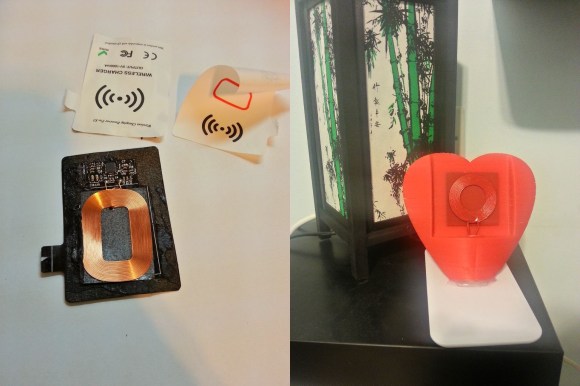
[Gal Naim] recently finished off an awesome Valentine’s day present for special someone. It’s a wireless charging heart for your phone!
He already had the Qi wireless charger but wasn’t much of a fan as it “looks so boring”. So he took it apart to salvage the charging circuit for his new project. As luck would have it, the Qi is very simple on the inside — all he had to do was lengthen the power wires to the coil. He then designed his heart in SolidWorks — Don’t forget to check out our 3D Printering tutorials on this — and printed it out in a nice candy apple red. To maximize the charging current he’s left the inductive loop on the outside so it can be as close to the phone as possible — he spray painted it red and it actually looks pretty cool!
The next step was adding the wireless charging capability to the phone, we’ve covered how to add this to any phone before, but for [Gal] it was as simple as cutting down the Qi Receiver card to fit in the phone.
If you want a bit more of a challenge though you can always make your own inductive charging loop!
















Awesome :) Just a note of caution, the minimum distance between the charging coils on the original pad might be deliberate to keep temperatures on the phone to acceptable levels.
So it’s now a cradle, sized for a specific phone. Kind of defeats the purpose of having a wireless charger. Might as well have just put a micro usb coming up at the bottom of the cradle instead.
These one-gadget wireless chargers seem so pointless. When there’s a large thin mat that can sit on my table top and charge my phone, tablet and macbook wirelessly, i’ll be impressed. But for now… meh.
Please don’t be so negative.
I disagree. In fact, I would say a thin pad on your desk might be somewhat useless if you have a usb-cable lying around which is faster and more efficient. The pads become interesting for places outside your home, like hotels and bars etc…
Single-device chargers still have the advantage of supporting any phone, regardless of where the actual usb connector is, so they would be perfect for a car phone holder where you dont wan’t to design for a specific device…
Might sound stupid but it works with induction, right? So what if I have an induction cooking machine…could I use it as a wireless charger?
Yes :) If you manage to protect your battery and phone, and get rid of any excess received power.
Won’t work with Qi though
Thanks Tom for replying.As I know it works only with iron. And as iron presence in a phone there’s enough: components’ protective shields, antennas and some screws. But the induction won’t work unless is in contact with the iron. So at a minimum 3 mm I think it’s safe. The power it’s adjustable so I can make it go from 85 watts to 850. I’m afraid that here’s the real problem. Even at 85 watts I might fry it. How much power does it makes a normal Qi charger?
I just finished designing and printing a desk stand for my Nexus 7 with integrated puck-style Qi charger. The charger is fed with microUSB, and to get the charger at the right height while having the cable feed out the back took some chopping of the strain relief.
I hadn’t considered taking it apart, soldering power leads directly to the input, and embedding the guts. I hang my head in shame.
If I get it right, phones which support Qi charging has two small pads for the Qi receiver under the phone’s blackplate?
So for example you can’t adapt the Qi receiver to a random phone, am I right?
that is true , but i have seen people run a thin wire to the usb port in the phone .
THe Qi receivers should produce a loadable, regulated output, so you might be able to hook it up to the 5V of the usb input. Not giving any guarantees ^^